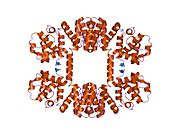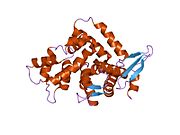Dystrophin
| View/Edit Human | View/Edit Mouse |

Dystrophin is a rod-shaped
Dystrophin is coded for by the DMD
Spontaneous or inherited mutations in the dystrophin gene can cause different forms of muscular dystrophy, a disease characterized by progressive muscular wasting. The most common of these disorders caused by genetic defects in dystrophin is Duchenne muscular dystrophy.
Function
Dystrophin is a protein located between the
Pathology
Dystrophin deficiency has been definitively established as one of the root causes of the general class of myopathies collectively referred to as muscular dystrophy. The deletions of one or several exons of the dystrophin DMD gene cause Duchenne and Becker muscular dystrophies.[13] The large cytosolic protein was first identified in 1987 by Louis M. Kunkel,[14] after concurrent works by Kunkel and Robert G. Worton to characterize the mutated gene that causes Duchenne muscular dystrophy (DMD).[15][16] At least 9 disease-causing mutations in this gene have been discovered.[17]
Normal skeletal muscle tissue contains only small amounts of dystrophin (about 0.002% of total muscle protein),
Though its role in airway smooth muscle is not well established, recent research indicates that dystrophin along with other subunits of dystrophin glycoprotein complex is associated with phenotype maturation.[19]
Research
A number of models are used to facilitate research on DMD gene defects. These include the mdx mouse, GRMD (golden retriever muscular dystrophy) dog, and HFMD (hypertrophic feline muscular dystrophy) cat.[20]
The mdx mouse contains a nonsense mutation in exon 23, leading to a shortened dystrophin protein.[21] Levels of dystrophin in this model is not zero: a variety of mutation alleles exist with measurable levels certain of dystrophin isoforms.[20] Muscle degeneration pathology is most easily visible in the diaphragm.[22] Generally, clinically relevant pathology is observed with older mdx mice.[22]
The GRMD dog is one of several existing dystrophin-deficient dogs identified where substantial characterization has been performed.[23] Clinically relevant pathology can be observed at 8 weeks after birth, with continued gradual deterioration of muscle function.[24] Muscle histology is most analogous to clinical presentation of DMD in humans with necrosis, fibrosis and regeneration.[25]
The HFMD cat has a deletion in the promoter region of the DMD gene.[26] Muscle histology shows necrosis but no fibrosis.[27] Extensive hypertrophy has been observed which is thought to be responsible for shorter lifespans.[28][27] Due to the hypertrophy, this model may have limited uses for DMD studies.
Therapeutic microdystrophin
- Delandistrogene moxeparvovec - systemic gene transfer with rAAVrh74.MHCK7.micro-dystrophin.[29][30][31]
Interactions
Dystrophin has been shown to
Neanderthal admixture
A variant of the DMD gene, which is on the X chromosome, named B006, appears to be an introgression from a Neanderthal-modern human mating.[37]
References
- ^ a b c GRCh38: Ensembl release 89: ENSG00000198947 – Ensembl, May 2017
- ^ a b c GRCm38: Ensembl release 89: ENSMUSG00000045103 – Ensembl, May 2017
- ^ "Human PubMed Reference:". National Center for Biotechnology Information, U.S. National Library of Medicine.
- ^ "Mouse PubMed Reference:". National Center for Biotechnology Information, U.S. National Library of Medicine.
- PMID 1319059.
- ^ "DMD - Dystrophin - Homo sapiens (Human) - DMD gene & protein". www.uniprot.org. Retrieved 1 December 2021.
- S2CID 7858296.
- ^ NCBI Sequence Viewer v2.0
- ^ Strachan T and Read AP, 1999. Human molecular genetics, BIOS Scientific, New York, USA
- ^ "dystrophin isoform Dp427c [Homo sapiens] - Protein - NCBI". www.ncbi.nlm.nih.gov.
- PMID 21312057.
- PMID 24021238.
- PMID 26295289.
- ^ S2CID 33548364.
- S2CID 4317085.
- S2CID 4364629.
- PMID 31819097.
- S2CID 42303520.
- PMID 17993586.
- ^ PMID 11917091.
- PMID 2662404.
- ^ S2CID 4302451.
- ISBN 978-0-429-16351-7.
- S2CID 6902011.
- S2CID 31250421.
- S2CID 38556669.
- ^ PMID 2683799.
- S2CID 21156994.
- ^ "Chugai In-Licenses Gene Therapy Delandistrogene Moxeparvovec (SRP-9001) for Duchenne Muscular Dystrophy | News". 16 December 2021.
- PMID 32539076.
- ^ "Delandistrogene moxeparvovec - Roche/Sarepta Therapeutics". AdisInsight. Springer Nature Switzerland AG.
- PMID 9356463.
- PMID 8576247.
- PMID 7890602.
- PMID 9412493.
- PMID 7844150.
- ^ Khan R (January 25, 2011). "Neandertal admixture, revisiting results after shaken priors". Discover Magazine. Archived from the original on January 27, 2013. Retrieved March 27, 2013.
Further reading
- Roberts RG, Gardner RJ, Bobrow M (1994). "Searching for the 1 in 2,400,000: a review of dystrophin gene point mutations". Human Mutation. 4 (1): 1–11. S2CID 24596547.
- Tinsley JM, Blake DJ, Zuellig RA, Davies KE (August 1994). "Increasing complexity of the dystrophin-associated protein complex". Proceedings of the National Academy of Sciences of the United States of America. 91 (18): 8307–13. PMID 8078878.
- Blake DJ, Weir A, Newey SE, Davies KE (April 2002). "Function and genetics of dystrophin and dystrophin-related proteins in muscle". Physiological Reviews. 82 (2): 291–329. PMID 11917091.
- Röper K, Gregory SL, Brown NH (November 2002). "The 'spectraplakins': cytoskeletal giants with characteristics of both spectrin and plakin families". Journal of Cell Science. 115 (Pt 22): 4215–25. PMID 12376554.
- Muntoni F, Torelli S, Ferlini A (December 2003). "Dystrophin and mutations: one gene, several proteins, multiple phenotypes". The Lancet. Neurology. 2 (12): 731–40. S2CID 34532766.
- Haenggi T, Fritschy JM (July 2006). "Role of dystrophin and utrophin for assembly and function of the dystrophin glycoprotein complex in non-muscle tissue" (PDF). Cellular and Molecular Life Sciences. 63 (14): 1614–31. S2CID 8580596.
External links
- GeneReviews/NCBI/NIH/UW entry on Dystrophinopathies
- Dystrophin at the U.S. National Library of Medicine Medical Subject Headings (MeSH)
- LOVD mutation database: DMD, DMD (whole exon changes)



